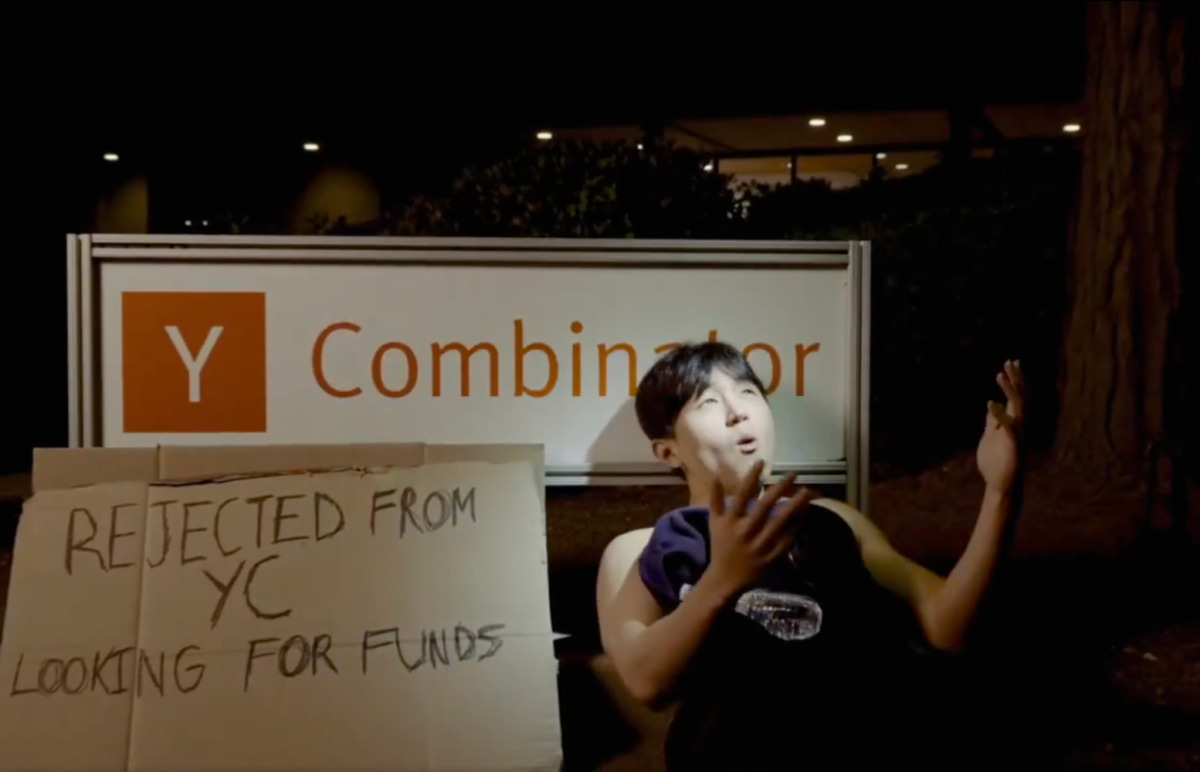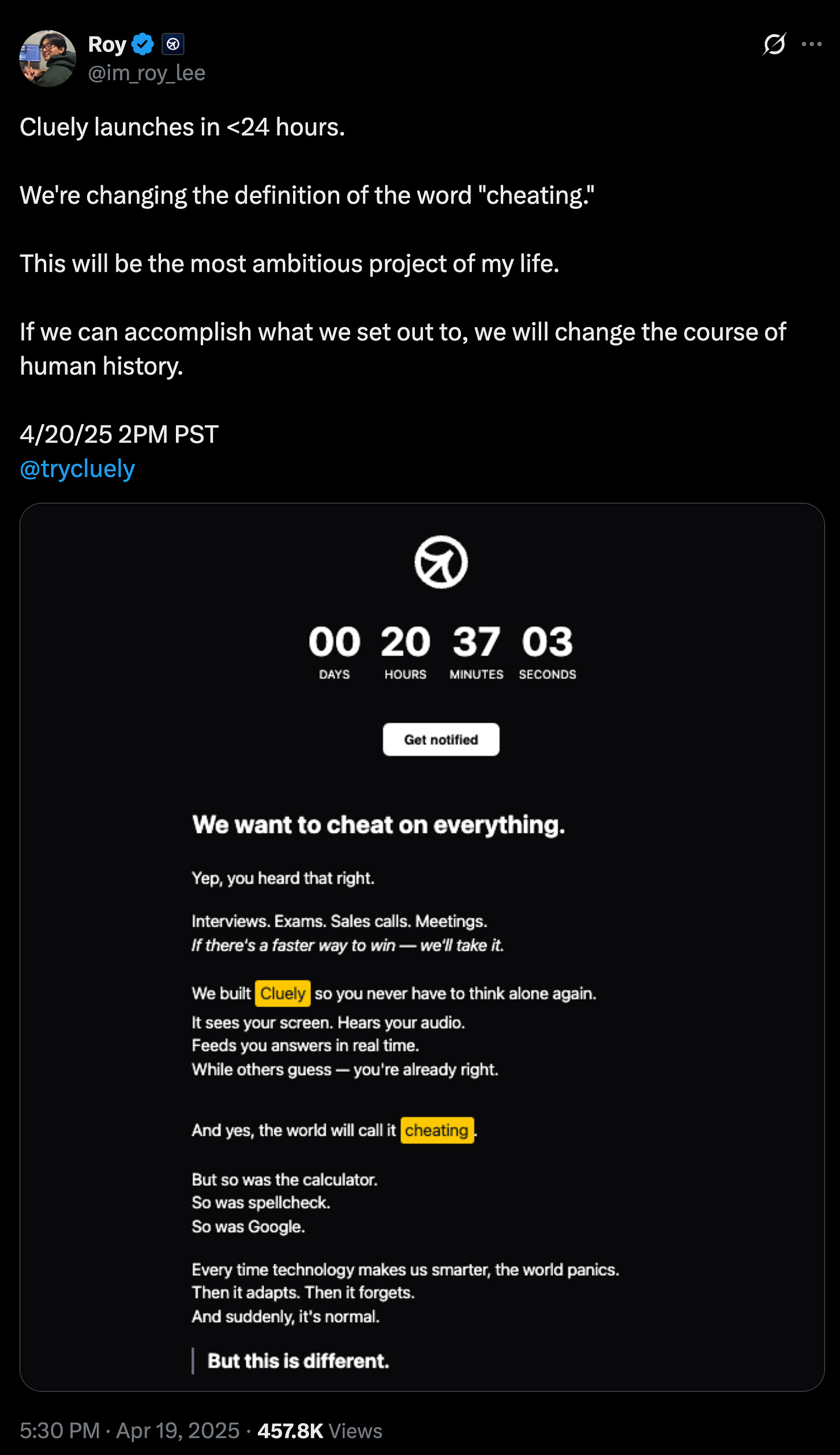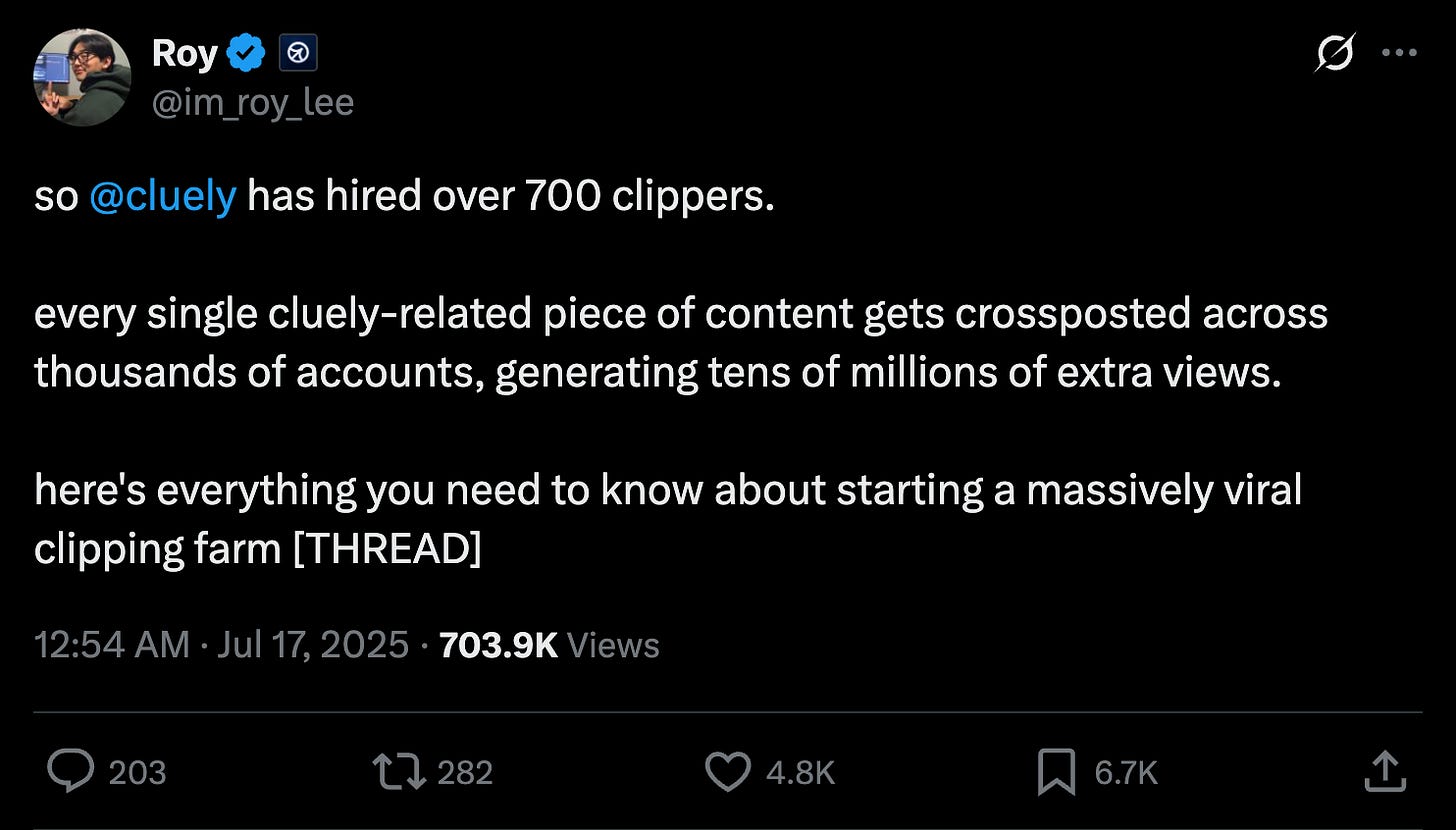Cluely: Can You Cheat Your Way to $120 Million?
🔥 Inside Roy Lee's radical "momentum as a moat" playbook 🔥
👋 Welcome to AI-native GTM!
AI-native companies are re-writing the GTM playbook. Every other week, I will highlight the stories and frameworks behind some of today’s fastest growing startups. You can expect deep dives, analysis and insights to inspire the next generation of AI-native founders and operators.
Today, we take a look at Cluely.
Year Founded: 2025
Headquarters: San Francisco, CA
Total Funding: $20M
Founders: Roy Lee, Neel Shanmugam
Let’s dive in 👇
The Unconventional Rise of an AI Assistant
In the span of less than a year, a provocative young entrepreneur has turned personal scandal into real momentum: $6 million in annual recurring revenue and $20 million in total funding at a $120 million valuation including a $15 million Series A from Andreessen Horowitz, and claimed profitability—all while operating with just 11 full-time employees.
Love it or hate it, Roy Lee's journey from Harvard reject to Silicon Valley sensation illustrates a new blueprint for startup success—one that prioritizes viral distribution over traditional product development and transforms founder authenticity (controversial or not) into a competitive advantage.
The company's secret weapon isn't superior technology or a breakthrough product feature—yet. Instead, it's a carefully orchestrated marketing machine that converts both praise and outrage into business results, challenging conventional wisdom about how modern companies should build their brands.
The Making of a Provocateur
Roy Lee's story begins with failure and reinvention. After gaining admission to Harvard University, Lee saw his acceptance rescinded following a school trip incident and what he describes as coordinated opposition from classmates.
The experience, which Lee calls "mentally tormenting," became a defining moment. Rather than retreat, he doubled down on what made him controversial in the first place. "I might as well just quintuple down on every single crazy belief, thought I have, and just live the most interesting life ever," he reflected in a recent interview.
This philosophy would later become the foundation of his business strategy. After enrolling at Columbia University, Lee connected with co-founder Neel Shanmugam and began experimenting with startup ideas. Their first attempt—an AI sales agent for liquor distributors—failed to gain traction, largely because, as Lee puts it, it "had nothing to do with me as a founder."
The breakthrough came with Interview Coder, a tool explicitly designed to help users cheat on technical coding interviews. Lee used the software to pass an Amazon interview, then went public with the story. The result was viral attention, expulsion from Columbia, and a blacklist from major tech companies. But it also proved a crucial point: when the product aligned with the founder's authentic persona, magic happened.
"I burned every other bridge except this," Lee explained, "and now this is the one path that's left for me."
The "Liquid Glass" Innovation
Cluely's core product is a translucent AI overlay that sits invisibly on users' screens, providing real-time assistance during meetings, calls, or solo work. Lee calls this user experience "liquid glass"—a seamless integration that doesn't require switching between applications or interrupting workflow.
The technology stack is deliberately simple: a React frontend wrapped in Electron, serverless backend infrastructure from Cloudflare, and AI capabilities powered primarily by OpenAI's GPT-4. For transcription, the company uses Deepgram's service to convert audio to text in real-time.
What makes Cluely distinctive isn't technical complexity but strategic positioning. While competitors like Fireflies.ai and Fathom focus on transparent, team-wide collaboration, Cluely has carved out what might be called the "covert advantage" niche. Its "Cheat on Everything" slogan deliberately embraced what other productivity tools avoid—the idea that users want an unfair edge, even if it means bending professional norms.
This positioning has proven particularly effective with sales teams and call centers, which now represent Cluely's core revenue engine. Sales representatives use the tool to access instant product knowledge and objection-handling responses during live customer calls, creating what Lee describes as the "stickiest use case" for the product.
The Anti-Fragile Marketing Machine
Cluely's go-to-market strategy operates on a counterintuitive principle: controversy is an asset, not a liability. The company has built what Lee calls an "anti-fragile" marketing engine that converts both positive and negative attention into brand awareness and sales leads.
The strategy relies heavily on Lee's personal brand as the primary distribution channel. His provocative personality and willingness to court controversy have made him what he calls the "main character of tech Twitter," generating a constant stream of viral moments that drive inbound interest.
Recent stunts include hiring a stripper for an office photoshoot, throwing a party that was predictably shut down by San Francisco police, and announcing plans to hire "50 interns" whose only job would be creating TikTok videos. Each incident generates waves of social media discussion, keeping Cluely in the conversation even among people who have never used the product.
"The only reason I have the contracts that I do right now is because the decision makers at these enterprise companies have seen my Twitter and think I'm funny and are rooting for me," Lee explains with characteristic directness. "I would never have had these contracts if I was just some lame person."
Scaling Through Influence
To amplify this approach beyond Lee's personal reach, Cluely has built an unusual workforce structure. The company's 11 full-time employees are split between just two functions: four world-class engineers and seven growth specialists. Notably absent are traditional roles like product managers or dedicated designers.
The growth team operates under an unconventional hiring criterion: every member must be a "world-class influencer" with at least 100,000 social media followers. This ensures that each new hire brings not just skills but also a built-in audience for marketing the product.
Beyond full-time staff, Cluely employs over 60 contractors as "UGC creators" who produce paid content about the company across TikTok and Instagram. This network recently generated 20 million views in just two weeks, creating the impression of ubiquitous brand presence.
The team operates from a six-bedroom San Francisco mansion that Lee describes as a "frat house, exemplified." The culture explicitly rejects work-life balance in favor of total immersion. "Your work should be your life, and vice versa," Lee states. "There is no work-life balance. Your entire life is Cluely."
The Revenue Reality
Despite the carnival atmosphere, Cluely's business metrics suggest substance behind the spectacle. The company operates on a dual model targeting both individual consumers and large enterprises.
Individual users can access a freemium version with limited functionality, while the full "Pro" plan costs $20 per month. Enterprise customers receive custom pricing for team deployments, with contracts reportedly reaching seven figures.
The symbiotic relationship between these segments is crucial to Cluely's success. The consumer-facing product and its viral marketing create the massive brand awareness that captures enterprise decision-makers' attention. High-volume, low-cost consumer adoption serves as an unconventional but highly effective lead generation channel for high-margin enterprise sales.
This approach has enabled Cluely to claim profitability while spending lavishly on team perks, including a reported $50,000 monthly food budget. The combination of rapid revenue growth, significant funding, and claimed profitability within roughly a year represents an unusually successful business trajectory.
The Competitive Landscape Responds
Cluely's provocative market entry has spawned both imitators and opposition. Direct competitors like LockedIn AI target the same covert assistance market with premium positioning and specialized features for high-stakes interviews.
More intriguingly, Cluely's success has created an entirely new category of "anti-Cluely" products. The most notable is Truely, developed by another Columbia student and explicitly marketed as a tool to detect unauthorized assistance during online meetings.
This opposition represents both validation and threat. It confirms Cluely's market impact while potentially undermining its core value proposition of undetectability. Lee has responded by downplaying the importance of stealth features, suggesting a strategic pivot toward transparency.
The Momentum Thesis
Underlying Cluely's entire strategy is a bet articulated by lead investor Bryan Kim as "Momentum as a Moat." The thesis holds that in the rapidly evolving AI landscape, traditional competitive advantages like proprietary technology or network effects matter less than the ability to capture attention and iterate faster than competitors.
When foundational AI models can be replicated or surpassed within weeks, the most durable advantage becomes superior distribution and execution speed. Cluely has inverted the typical startup sequence, building massive distribution first and using the resulting attention and revenue to guide product development.
This approach prioritizes "mindshare" above conventional metrics. By becoming the most talked-about company in its space, Cluely creates a powerful flywheel: attention attracts talent, talent builds better products, better products validate the attention, and the cycle accelerates.
The Risks of Playing With Fire
For all its early success, Cluely's strategy carries significant long-term risks that could undermine its growth trajectory.
The "cheat on everything" brand positioning creates fundamental tension with enterprise needs for trustworthy, secure software. A tool that accesses users' screens and microphones requires deep customer trust—exactly what provocative marketing tends to erode. Lee himself acknowledges this challenge, questioning whether his "crazy reputation" can coexist with enterprise customers' security requirements.
The company faces what might be called the "hype-reality gap." Early user feedback on platforms like Reddit includes pointed criticism, with some calling the product "mid" or questioning whether marketing has outpaced actual functionality. If product quality doesn't rapidly improve to match the enormous expectations created by viral marketing, the company risks catastrophic churn and reputation collapse.
Perhaps most critically, the entire marketing engine depends on Lee's personal brand. The inbound lead pipeline isn't generated by "Cluely's marketing" but by "Roy Lee's antics." This creates extreme founder dependency—if Lee's persona loses appeal or if he were to leave the company, the primary growth mechanism would likely collapse.
Lessons for the New Era
Despite its high-risk nature, Cluely's approach offers instructive lessons for modern startup builders, particularly in fast-moving markets where traditional advantages quickly erode.
Founder authenticity as competitive advantage: The most memorable brands often emerge when founders lean into their authentic personalities rather than adopting generic corporate personas. Lee's willingness to embrace his controversial history created a powerful marketing asset that no competitor can replicate.
Distribution as a design principle: Rather than treating marketing as a downstream function, successful companies increasingly build distribution capabilities into their core structure. Cluely's strategy of hiring influencers as employees demonstrates how organizational design can create organic growth channels.
The power of contrarian positioning: In crowded markets, being polarizing often proves more effective than being agreeable. By explicitly embracing "covert individual advantage" while competitors focus on "transparent collaboration," Cluely carved out a unique and memorable market position.
Speed as strategy: In rapidly evolving markets, the ability to move faster than competitors can matter more than having the best initial product. Cluely's "momentum as a moat" thesis suggests that sustainable competitive advantage increasingly flows from execution velocity rather than technological superiority.
The High-Wire Act
Cluely represents an extreme experiment in modern startup building—a test of whether a powerful distribution engine can generate enough momentum for product quality to catch up with marketing promises. It's a high-wire act that most companies shouldn't attempt, but one that offers valuable insights into the changing nature of competitive advantage.
The company's trajectory over the next year will provide crucial data on whether the "distribution-first" model can sustain long-term growth or whether the gap between hype and reality will ultimately prove fatal. For now, Cluely stands as perhaps the most fascinating case study in how authentic controversy, strategic provocation, and relentless execution can transform personal scandal into business success.
As Lee himself frames it, the ultimate question isn't whether his approach is conventional or comfortable, but whether it can scale fast enough to "hit escape velocity before pissing off too many people." In the fast-moving world of AI startups, that might be the only timeline that matters.
This analysis is based on public information, interviews, and company materials as of July 15, 2025. Some details may have changed since publication.







